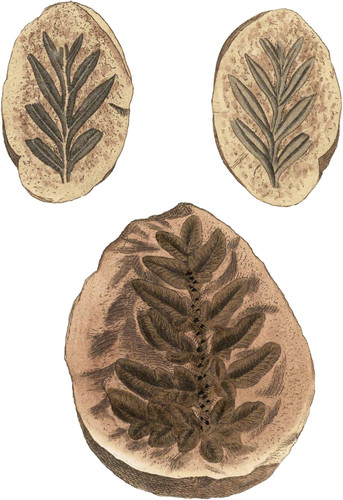 Enlarge
Enlarge
British Mineralogy
Argillaceous Iron-Stone
- Class 3. Metals.
- Order 2. Mixed.
- Gen. Ferrum oxygenizatum.
- Spec. Argillaceum.
- Div. 1. Amorphous.
Iron-stones with vegetable impressions, or rather exuviæ, have been much noticed by many writers, but have scarcely been admitted into mineralogical works: we should, therefore; be at a loss in most instances to find an account of them, where we would wish to see them spoken of as a part of the great system, especially of the phænomena of the change, or seeming conversion, of one substance into another. How bits of ferns or such plants should become so regularly immersed in the clayey Iron-Stone balls upon the Coal strata as they are found to be, can only be guessed at. They not only contain a certain portion of the plant, but often so regular a fragment that it would hardly be possible to put a more complete fragment between two pieces of clay, and press them into a ball, more or less ovate, as these generally are. Were I to endeavour to account for this appearance, I should suppose the plants to have been formerly in or near ferruginous loamy or clayey soil; that their tops being much shaken as by a watery or showery tempest, were continually heating against the unctuous clayey cliff, and thereby became loaded with clay, till the branch was detached by help of its cumbrous load; and being at length covered by the deluged soil, has remained to this time, a lasting memorial of a catastrophe of which we can only expect to see such signs, although it seems to say we are indebted to it for the Coal formation, which I think Is more confirmed in these instances. The peculiar change here wrought is an excellent specimen to show us that, under these particular circumstances, all vegetables then existing, however large or small, might undergo, by natural gravity, the changes that, as I have before said, preserve whole forests in the different forms of coals for the use of future ages. Thus the vegetable, in this instance, could but allow of certain of its most volatile parts, which gave it bulk when living, to pass into the clay, at the same time admitting of others to help the change. In general, Carbon and Bitumen are the ingredients of the remains, though sometimes it is nearly the same with that of a common brown dead leaf. The process of carbonization is occasionally carried on above ground , as in some Fungi—see Agaricus Elephantinus, tab. 36, and aurantius, tab, 381, Eng. Fungi. Dead leaves often become carbonized above ground; but the most frequent form of Carbon above ground is organic, as in Sphæriæ—see Eng. Fungi, tab. 372, 373, and 374, &c.
The observation that both sides of the impressions exhibit the same side of the leaf, is nearly correct. It seems that the front of the leaf is least liable to decomposition, and that the impression is opposite to it; the substance of the leaf, chiefly the front, remaining on the other half when it is detached. Only the inner side of the cortex, apparently, is seen, and I do not know that any signs of the fructification, which should be on the edge or other part of the back, have ever been detected, either in the impression or otherwise. The two upper figures seem to have been a Pteris, if we can guess by what remains. The right hand one is the concave impression, and the other the convex one that fitted it. The lower figure is a lobated fern, and is also, perhaps, a Pteris. It is lodged in rather irony clay, and has a coaly film in some parts, and small fragments of coal are among the squamæ. Some have much more coal on the leafy surface. Indeed the edges of some of my specimens have little hollows, and a margin of Carbonate of Lime and Pyrites, where the fruit may perhaps have been.

